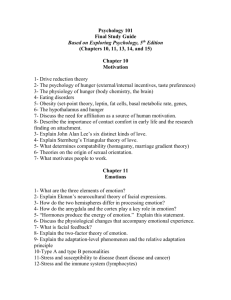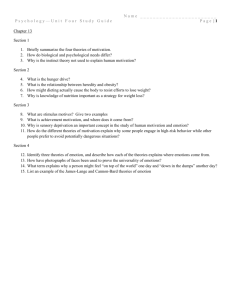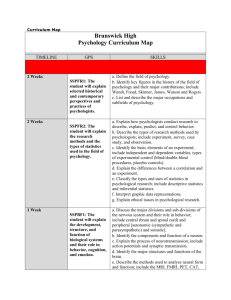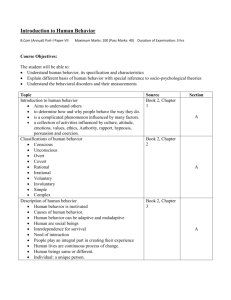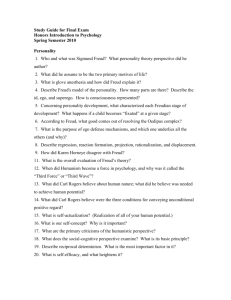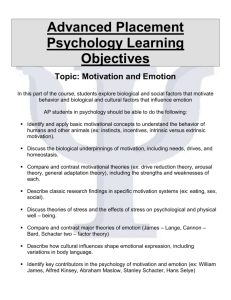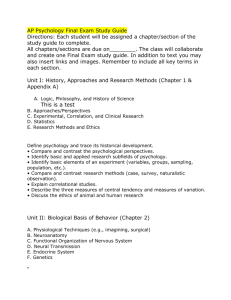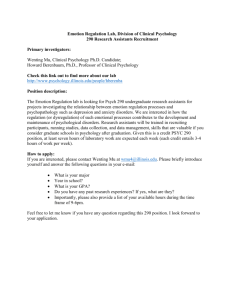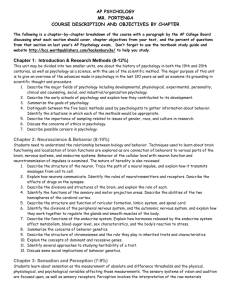American Psychological Association
advertisement
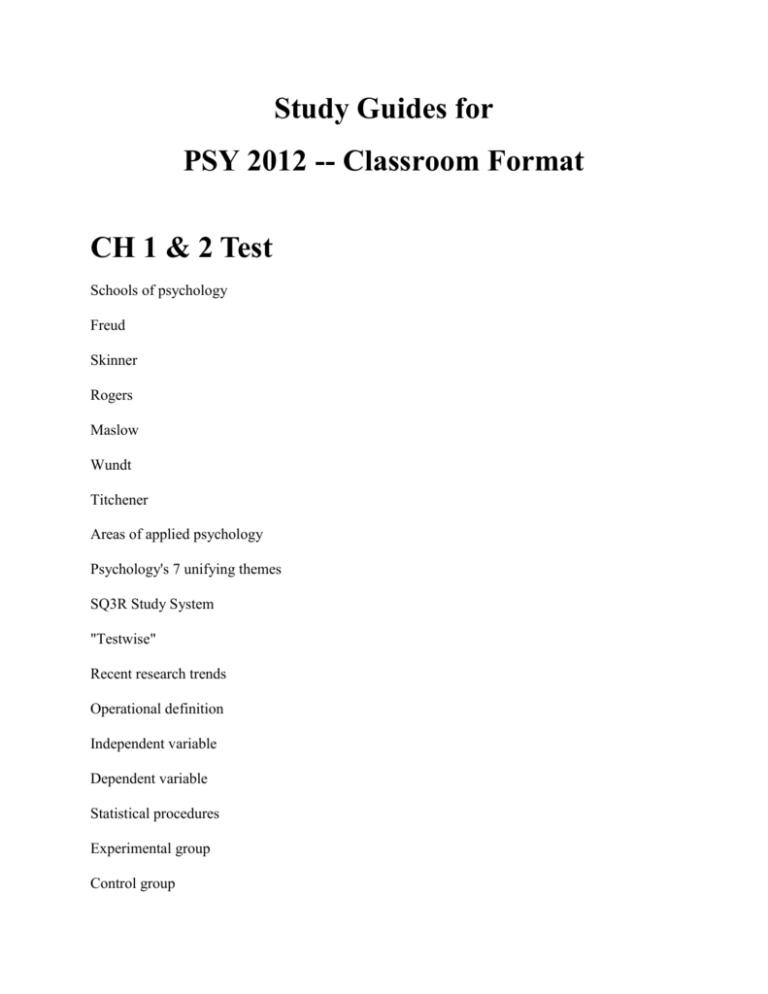
Study Guides for PSY 2012 -- Classroom Format CH 1 & 2 Test Schools of psychology Freud Skinner Rogers Maslow Wundt Titchener Areas of applied psychology Psychology's 7 unifying themes SQ3R Study System "Testwise" Recent research trends Operational definition Independent variable Dependent variable Statistical procedures Experimental group Control group Placebo Correlation Correlation coefficient Causation Research methods Confounding (extraneous) variable Random factor Social desirability bias Double-blind procedure Experimenter bias Deception PsychINFO Journal article format Anecdotal information Major assumption of science Sampling CH 4 & 5 Test Sensation Perception Electromagnetic radiation spectrum Aspects of vision Wavelength Amplitude Saturation Nearsighted Farsighted Subtractive color mixing Additive color mixing Opponent process theory of color vision Trichromatic theory of color vision Monocular depth cues Binocular depth cues Perceptual constancy Sound waves Middle ear Basilar membrane Cochlea Oval window Ossicles Eardrum Place theory Two chemical senses Types of sensory receptors Sensory adaptation Pain messages Gate-control theory of pain Glial cells Gestalt principles of perception Attention Consciousness Jet lag Melatonin Brain wave activity Sleep cycles REM sleep REM rebound Sedative-related problems Freud's theory of dreaming Activation synthesis model Hypnotic induction Effects of hypnosis Meditation effects Categories of drugs Physical dependence Psychological dependence Sleep requirements Latent content Manifest content CH 6 & 7 Test stimulus discrimination stimulus generalization operant conditioning observational learning classical conditioning CR UCR CS UCS behavior modification shaping resistance to extinction primary reinforcer secondary reinforcer positive reinforcement negative reinforcement avoidance learning side effects of punishment escape avoidance spontaneous recovery 3 memory processes levels of processing theory phonemic encoding semantic coding structural encoding elaboration visual imagery memory theories semantic network source-monitoring error Ebbinghaus forgetting curves retention interval measures of memory retention pseudoforgetting causes of forgetting studies of long-term memory proactive interference retroactive interference hippocampus declarative memory procedural memory implicit memory schemas misinformation effect repressed memory memory techniques eyewitness testimony influences on eyewitness testimony encoding specificity principle CH 8 & 9 Test inducing structure types of heuristics types of cognitive styles types of fallacies evolutionary psychology Alfred Binet and Theodore Simon normal distribution of a characteristic validity reliability heritability Flynn effect Gardner's theory of intelligence divergent thinking creativity test types of motives (motivators) goal-directed behavior Cannon and Washburn blood glucose level/hunger Masters and Johnson phases of human sexual response gender differences in sexual behavior types of emotional-sexual relationships TAT Components of emotion Measurement of cognitive component of emotion autonomic arousal amygdala body language cross-cultural emotional expressions theories of emotion unifying themes of the chapter factors related to happiness premises common fallacies of reasoning CH 10 & 11 Test cephalocaudal trend proximodistal trend maturation types of attachment characteristics of securely attached children separation anxiety research Erikson's stages of psychosocial development Piaget's stages of cognitive development object permanence conservation irreversibility centration nativist theories evolutionary theories primary sexual characteristics secondary sexual characteristics prefrontal cortex research suicide research identity statuses trends in marriage physical change in aging adults unifying themes of the chapter Freud's psychoanalytic theory other personality theories (perspectives) reaction formation repression rationalization regression Jung's theory Alfred Adler compensation Dr. Hewlett B. F. Skinner Albert Bandura Walter Mischel Carl Rogers Abraham Maslow Hans Eysenck Research on personality heritability behavioral genetics Big Five personality traits terror management theory uses of personality tests Raymond Cattell 16 Personality Factor Questionnaire MMPI Rorschach Test NEO Personality Inventory CH 12 & 13 Test types of stress types of conflict Social Readjustment Rating Scale Hans Selye General Adaptation Syndrome responses to stress types of coping Type A personality Type B personality heart disease risk factors barriers to healthcare provider-patient communication stats on noncompliance with medical advice correlation optimal-arousal theories behavioral responses to stress etiology DSM IV axes types of anxiety disorders types of somatoform disorders types of dissociative disorders types of mood disorders stats on depression ruminate flattened emotion schizophrenia genetic-influenced disorders pancultural view of psychological disorders eating disorders types of heuristics CH 14 & 15 Test major types of therapy stats on therapy usage unconscious defensive client maneuvers types of therapists Carl Rogers unconditional positive regard genuineness empathy systematic desensitization spontaneous remission social skills training types of therapeutic psychotropic drugs atypical antipsychotic drugs homeless statistics effectiveness of therapists sexual exploitation of clients regression toward the mean (average) mental health professionals & their training branches of psychology person perception stereotype types of attributions research on reciprocitiy types of adult attachment individualism collectivism attitude components of attitudes aspects of persuasive communication characteristics of effective persuasion types of persuasive arguments techniques for attitude change Milgram's research on obedience diffusion of responsibility group think the bystander effect group polarization Prejudice -- acquiring and maintaining it compliance techniques CH 1 - 15 (FINAL EXAM) William James' theory functionalism's contributions structuralism research psychology specializations SQ3R theory correlation coefficients myelin sheath parts of a neuron norepinephrine serotonin visual cortex electromyograph narcotics cocaine sleep deprivation Pavlov's principal experiment extinction classical conditioning instrumental conditioning escape learning avoidance learning phobias -- acquiring and maintaining Garcia's study of rats schema ways memory is measured proactive interference serial-position effect bell-shaped curve (statistics) adoption studies of intelligence Flynn effect Sternberg's intelligence theory Gardner's intelligence theory knowledge about creativity sexual phases described by Masters and Johnson autonomic arousal components of an emotion development of attachment to mothers cognitive change in older adults Cattell's personality theory reaction formation displacement rationalization projection Jung and Adler's disagreement with Freud types of conflict effect of stress on the immune system anxiety disorders generalized anxiety disorder panic disorder somatoform disorders dissociative disorders dissociative amnesia dissociative fugue schizophrenic disorders most important aspect of group therapy evolutionary psychology four basic elements of persuasion a group
